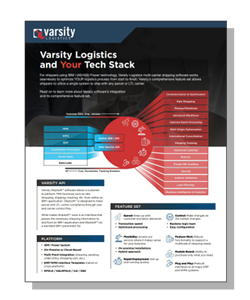
Mastering Market Volatility: 5 Ways Shipping Software Helps You Weather the Storm
You can’t always predict the unexpected, but you sure can prepare for it
In 2020, a global pandemic forced our world into a lockdown, causing productions to shut down, surges in unavailable product demand, and delays at ports. In 2022, 1,743 entities were impacted by supply chain cyber-attacks in the U.S., a 235% increase year-over-year since 2017. In 2023, anticipation of a potential strike by UPS Teamsters triggered a defensive response in many businesses, increasing costs for alternative shipping options, stress and anxiety, and many other harmful effects. Uncertainty regarding capacity exceeding demand adds another layer of complexity, as businesses grapple with questions about how many carriers will survive or merge in the face of changing market dynamics. Not to mention, other threats of disruption, like natural disasters and labor concerns, continue to loom over the supply chain and logistics industries.
You might be wondering: What’s the point of calling out these examples of market volatility? The point is, the supply chain and logistics landscape changes rapidly, constantly evolving. At the same time, they’re consistently faced with irregularities and the unknown. The possibility of supply chain disruption can occur at any time, especially when we least expect it. So, how can businesses be prepared for the unexpected?
Not only understanding, but also preparing for these market dynamics is crucial for businesses looking to excel in today’s volatile shipping environment. An advanced supply chain technology solution, such as a Transportation Management System (TMS) or multi-carrier shipping software built for both parcel and LTL shipping, emerges as the strategic key, offering a variety of tools and capabilities designed to help you navigate uncertainty. Let’s explore how these solutions can set your shipping operations up for success against unforeseen circumstances and market volatility.
How Top-Tier Multi-Carrier Shipping Software (MCSS) Keeps Your Shipping Operations Resilient
From visibility to automation and provider expertise, here are five ways a robust shipping software solution can help you adapt to evolving market conditions and provide the control you need to weather any storm:
1. Enhanced Visibility: Industry leading multi-carrier shipping software offers real-time visibility into the entire supply chain ecosystem. Advanced tracking and monitoring gives businesses visibility to several factors including shipment status, carrier performance, inventory levels, and market conditions. This provides companies with the ability to quickly detect disruptions and proactively respond to any unexpected obstacles.
2. Optimized Routing: In times of supply chain disruption, a shipping software’s optimized routing capabilities can really make a difference. The software can analyze various factors like traffic conditions, carrier capacity, and delivery windows, to select the most efficient route avoiding any disruptions. This way, businesses can still minimize transit times and adapt to volatile market conditions.
3. Improved Communication: Superior shipping software platforms integrate seamlessly with other parts of the Enterprise Software Stack (ESS), ensuring smooth data exchanges and streamlining operations. This also allows for uninterrupted communication between shippers, carriers, and customers. By maintaining real-time communication between the different parts of the supply chain, it helps businesses keep stakeholders informed to swiftly mitigate the impact of unforeseen circumstances and vice versa.
4. Automation: The ability of a comprehensive multi-carrier shipping solution to automate manual tasks and streamline workflows improves overall operational efficiency and agility. Not only do automated processes reduce the risk of costly errors, but they enable businesses to quickly adapt to sudden market changes, ensuring high service levels even in unpredictable events.
5. Expertise: A top-tier shipping software provider’s expertise is invaluable when it comes to preparing shippers for market volatility. Experienced providers offer strategic guidance, innovative solutions, and proactive support. Leveraging their strong industry knowledge, these providers can assist businesses in anticipating potential risks and developing contingency plans to mitigate them. By partnering with an experienced shipping software provider, shippers can lean on a trusted resource to help them navigate turbulent times and ensure resilience in supply chain uncertainty.
Varsity Logistics: The Leading Provider of Multi-Carrier TMS Systems
While it’s clear that unforeseen circumstances and instances of supply chain volatility are inevitable, Varsity Logistics’ comprehensive shipping software solution is the obvious choice for safeguarding your shipping operations against them. Varsity Logistics is the industry-leading multi-carrier shipping software provider exclusively designed for shippers on the IBM i (AS/400) Power systems. Included in our parcel shipping suite are various robust functionalities and supply chain execution modules, built for even the most complex shipping challenges. As a premium shipping solution, we help you protect your shipping operations with our:
Supply Chain Visibility
Electronically linked via Varsity’s ShipTalk module, your shipping software is seamlessly connected to your carriers to provide your business with real-time, end-to-end visibility into various parts of the supply chain. This functionality gives insight to variables such as current time order updates, delivery status, and advanced tracking and tracing. The visibility ShipTalk provides gives companies the ability to swiftly identify disruptions and take proactive action.
Carrier Selection
Another functionality Varsity provides as an important tool in mitigating supply chain disruptions is our carrier selection process. Based on a list of criteria including transit time, cost, mode, performance, optimal carriers, and more, Varsity’s ShipSelect module chooses the best carrier for every single shipment. This kind of functionality offers your business an automated way to still select the optimal carrier option for your shipments even during volatile supply chain conditions.
Streamlined Communication
Varsity’s shipping software solution offers the most robust and powerful integration possible with IBM i ERPs, making it the clear choice for IBM i (AS/400) Power systems users. This seamless integration allows for smooth communication and real-time shipping data access, empowering IT and e-commerce teams to stay informed of any potential threats or disruptions, allowing for immediate collaboration and proactive responses. [Learn why Varsity is the preferred shipping software partner of VAI!]
Automated Workflows
Automation plays a big role in helping shippers mitigate volatility. Varsity’s ShipSoft-Parcel solution automates the entire shipping process from start to end, eliminating the risk of expensive manual errors. From optimizing shipment pricing to ensuring label compliance, our automated solution ensures quick adjustments to your shipping strategies in response to shifting market conditions, like disruptions in transit routes. Additionally, our ability to conform to business requirements and industry compliance standards guarantees shippers a reliable solution regardless of supply chain challenges.
Supply Chain Expertise
We absolutely agree that the experience of your shipping software provider is invaluable, especially with unforeseen circumstances consistently looming. Founded in 1989, Varsity Logistics is proud to share that we hold over nearly 40 years in the supply chain and logistics space under our belt. Additionally, the tenure of our services and support teams surpasses 120 years. With that much experience, we know best when it comes to preparing shippers for resilience against market volatility.
Additional Features
There are many more capabilities of Varsity’s shipping modules that go beyond this list, but it’s important to mention:
- Auditing: Varsity’s ShipAudit module reconciles carrier invoices against the anticipated costs, eliminating over-charges, duplicate bills, or invalid charges. Overall, by protecting profitability, ShipAudit helps companies fortify their supply chains against disruption and encourages operational continuity.
- Analytics: TransData is Varsity’s transportation analytics tool that provides shipping companies with access to organized historical shipping and carrier data, enabling them to analyze performance, monitor trends, and make informed decisions. Leveraging this data helps businesses negotiate better agreements with carriers and reduce costs, thus helping to mitigate the impacts of a volatile shipping market.
- Containerization: The ShipOptimizer module revolutionizes shipping operations by providing companies with the ability to predict shipping costs accurately before product shipment, offsetting rising transportation expenses and enhancing warehouse efficiency. By optimizing the container packing process, this module enables companies to seamlessly manage complex fulfillment requirements, reduce operating costs, and minimize potential product damage, ultimately helping companies navigate the challenges of supply chain disruptions.
To learn more about the modules mentioned above and Varsity’s comprehensive selection of parcel, freight, analytics and auditing shipping solutions, visit our resource center.
Varsity Logistics’ industry-leading multi-carrier shipping software is more than a shipping tool; it’s an essential piece of your supply chain software solution helping to safeguard your IBM i (AS/400) shipping strategy against the unexpected. Offering a valuable set of capabilities, including enhanced visibility, optimal carrier selection, streamlined communication, automated processes, and provider expertise, Varsity provides the solution to equip your shipping strategy for whatever’s around the corner.
Ready to weather the storm and take on supply chain disruptions with confidence? Contact our team of shipping experts or schedule a demo to learn more about how Varsity can help you navigate the ever-changing parcel shipping landscape.




